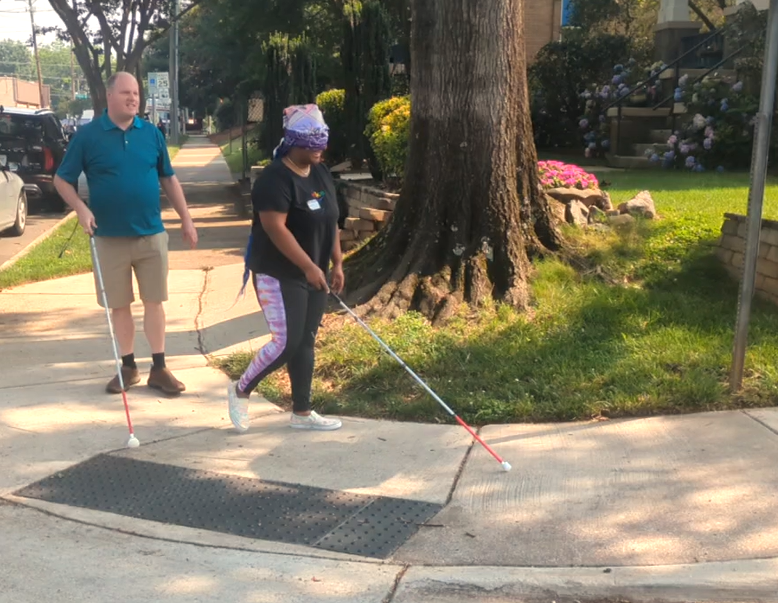02.26.2024

Image alt text: Brad, wearing tan shorts and a teal polo shirt, walks with his cane down the sidewalk near the Metrolina Association for the Blind office. He is instructing a woman on cane use. The client, also using a mobility cane, walks in front of Brad. She wears a purple blindfold, a black t-shirt, and black leggings with a purple tie-dye edge. Near the sidewalk is a lawn with a large tree, a low brick wall, azaleas and hydrangeas in bloom, and steps ascending to the porch of a house.
Metrolina Association for the Blind instructor Brad Blair is grateful for the skills he learned—at times, was forced to learn—as a child. Born blind, Blair worked with several teachers of the visually impaired (TVI) as his military family bounced around Tennessee, Texas, and again Tennessee.
Like almost any child at one time or another, Blair didn’t always welcome his lessons. In addition to basic literacy, math, and science instruction, Brad also learned Braille, orientation and mobility, and independent living skills aimed at making him a confident, independent adult who, as he puts it, “just happens to be blind.” And he is glad he had teachers who were tenacious enough to insist that he learn.
In his work at MAB, Blair teaches clients how to safely navigate public spaces, cross streets, cook for themselves, even take a train to another city—all without relying on sight. It’s a skill set he’s built slowly over his lifetime, one which has lent a unique perspective to his training and practice now. Blair has certifications in orientation and mobility, assistive technology instruction, and vision rehabilitation.
Blair talked about his experiences growing up as a blind person, navigating the sometimes unpredictable world of services for the blind and visually impaired, as the keynote speaker at the Tennessee Chapter AER Conference in February. AER is short for the Association for Education and Rehabilitation of the Blind and Visually Impaired. Brad is the district representative to the AER international board of directors.
The conference theme was “From Cradle to Grave: An Intergenerational Perspective.”
While Blair can certainly speak about his experiences as a blind person in several phases of life, he admits that there is one kind of experience he has not had.
“One part of the journey that I cannot relate to, and many of you cannot relate to, is the actual journey of vision loss,” he said. “When it comes to coaching and counseling folks through the psychosocial adjustment to vision loss, I have to be careful because I’ve not been on that journey, and I’m not going to pretend I have been. But I can show them that whatever the end point of their vision loss is, there are skills out there that will help them.”
Because most of the conference attendees are TVIs or vision rehabilitation specialists, Blair emphasized the importance of early skills training. Services for adults are not as reliably available as those for children, so he cautioned against procrastination.
“I tell my kiddos in the schools, especially my high schoolers: get all the services you can, because once you graduate, it’s going to be hard,” Blair said.
In some areas, the services just aren’t there, particularly for adults, like homemakers and retirees, who are not seeking vocational rehabilitation. He spoke of one elderly client who sold his home and moved into a retirement community despite having the physical and mental capacity to live on his own.
“He didn’t know what else to do,” Blair said. “He didn’t know about skills training.”
Often, once adults are connected with services, they may have experienced depression, loss of vocation, even homelessness. Blair said all he can do is meet them where they are.
“Some of them have pretty good residual usable vision; some of have, as I like to put it, just enough vision to get themselves in trouble,” he said. Surprisingly, he sees the biggest gap in services is not in skills training, but in confidence building.
Blair said, “Ninety percent of what I do is in people’s heads. I try to help them see that whatever they think is impossible is not impossible.”
Recently, he’s begun teaching Braille to a Susanna, who has diabetic retinopathy. Despite pervasive messaging that she is “too old” to learn Braille, Susanna is not going to let vision loss set unnecessary limits. She is 74.



